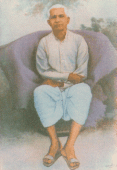
Yogananda Maharaj

Shri Yoganandaji Maharaj, originally known as Daya Shankar, was born in Junagar, Gujrat at the beginning of the present century. The exact place of birth of Shri Yoganadaji is not known since he was always reluctant to give any details about his private life. He confined himself to talking about Yoga practices, devotion and spiritual advancement. The father of Shri Yogananda died quite early and the family became poverty stricken; consequently his educational advancement was limited. His initial efforts of earning his livelihood in Bombay failed as he was totally straightforward in his dealings with people. In addition, he had a genuine love for the company of saints. His indifference toward the world gradually increased and ultimately he renounced his home in search of a competent master. At that time, he was attracted to Shri Tri Vikram Swami, a spiritual master who resided near Prabhas Patan, and Shri Atmanandaji Saraswati, who resided in Brahma Teertha near the Ganges. He acquired a knowledge of yoga but was not satisfied with it. Ultimately he met Shri Krishnanandaji Maharaj, a Bengali Brahmachari (aspirant of God). The Brahmachari was a great devotee and used to do japa (chanting) of the Gayatri Mantra constantly.
The two became so close to each other that they became lifelong companions. Although the Brahmachari was basically a devotee and Daya Shankar had interest only in yoga, their intimacy and liking for each other were that of a teacher and a disciple. Brahmachari Krishnananda was always keenly searching for a competent teacher of yoga for his disciple, Daya Shankar. At last Krishnanandaji came to know about Swami Narayan Tirth Maharaj of East Bengal and they set out to meet him. They reached there after a long journey. Krishnanandaji approached Swami Narayan Tirth in the following straightforward manner: "If you really have anything to give, please shower your grace on my disciple but please do not confuse us any further."
The swami replied, "I am not a hypocritical saint. If your disciple remains unsatisfied with me, it would mean that there is something basically wrong with his state of consciousness. You have, any way, come to the right place and I can only assure you not to doubt about the true light that your disciple can get here." The Swami thereafter initiated Daya Shankar into Shaktipat, who came to be known as Yogananda Brahmachari and finally as Yogendra Vigyani.
Shri Yoganandaji and the Brahmachari stayed together in the Ashram (spiritual center) and continued spiritual practices. Shri Yoganandji soon started having rich yoga experiences. He experienced a number of automatic movements during his meditation. The Swami was very pleased with Krishnanandaji, whom he wanted to empower for the purpose of initiating others, but Krishnanandaji, basically a devotee, declined this and instead requested Swamiji to empower Yoganandaji with the ability to initiate others. Yoganandaji, who was only sitting there, clarified that he was already empowered to initiate others as Swamiji had so desired through Brahmachariji. He thereafter bowed down before the two saints who actually blessed him with that power.
On the way back from the Ashram of Swami Narayan Tirth Maharaj, Yoganandaji sojourned for some time in a few other spiritual centers. He experienced many miraculous and mysterious automatic movements during his sadhana. Finally, he thought of settling down after constructing a cottage in the village of Mandu near the Ganges River in Uttar Pradesh. However, when the place was ready, Brahmachari Krishnanandji, visiting there, declared that the center was polluted by the affairs of money, and that it was an undeserving place for Yoganandaji to live. Yoganandaji therefore immediately left the new Ashram and never looked back. He thereafter stayed in Swargashram in Rishikesh and established Vigyan Ashram there. Later on he became known as Yogendra Vigyani. Shri Yoganandaji initiated a number of aspirants into the Shaktipat system, including Swami Vishnu Tirth Maharaj and Swami Shankar Pururushottam Tirtha. He wrote a notable book in Hindi entitled Mahayog Vigyan. He left his mortal form in 1959 dissolving into the Absolute.
Version 1.0, August 1995
Copyright Narayan Prakash and Kurt Keutzer, 1995
(73122.1631@compuserve.com or keutzer@eecs.berkeley.edu)
The authors grant the right to copy and distribute this file, provided it
remains unmodified and original authorship and copyright is retained.The
authors retain both the right and intention to modify and extend this
document.